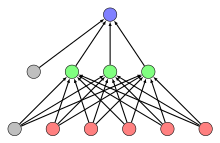Commons:Valued image candidates/Perceptron-unit.svg
Jump to navigation
Jump to search
Perceptron-unit.svg
| Image |  |
|---|---|
| Nominated by | MartinThoma (talk) on 2016-05-30 11:35 (UTC) |
| Scope | Nominated as the most valued image on Commons within the scope: Single Perceptron unit |
| Used in | Global usage |
| Review (criteria) |
|






